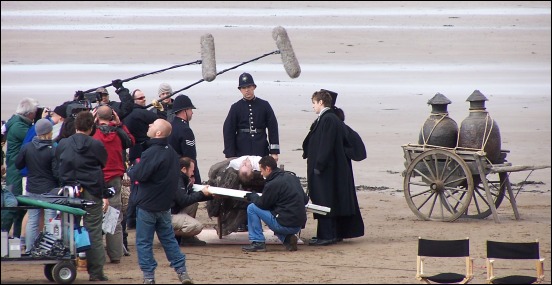In 16:9
http://s27.postimg.org/xtcuaaez7/Alyx_Vance_cropped.jpg
You don't think the latter framing conveys more presence and intimacy ?
Cheers


Follow along with the video below to see how to install our site as a web app on your home screen.
Note: This feature may not be available in some browsers.
In 16:9
http://s27.postimg.org/xtcuaaez7/Alyx_Vance_cropped.jpg
You don't think the latter framing conveys more presence and intimacy ?
Cheers


Cinema primarily pushed for wider aspect ratios for framing wider vistas, think westerns; Without the wide screen format, the screen would primarily be filled with uninteresting sky and dirt,
Same goes with games. Aerial dogfighting simulators aside, everything interesting happens in a horizontal plane (surface of the Earth).
Cheers
yes true, but will they have so many portrait shots 9:16 I think would look too narrow in a lot of casesThe existence of good 4:3 photography would never be doubted. Artists always adapt to their medium. Given 4:3 to work with, the photographers did a great job with it. Given 16:9, they do a great job with it.
Visual field preference is really a discussion for another thread. I'll just throw in that it's more psychological to prefer widescreen. The sky and the ground at your feet are generally irrelevant to understanding a situation - there's a reason why Hollywood chose the aspect ratios they did, and it was to get meaningful content onto their expensive film instead of filling the screen with clouds and road/grass.

You're not cutting anything off, you have a wider field of view. Since almost all action in movies or games happen in the 7 feet immidiately above ground all the way to the horizon, there is very little point spending screen real estate above and below what is needed to display that.
Why would FOV be the same as 4:3? you have a wider screen and a wider field of view.
Nobody games in portrait mode. Nobody uses surround gaming by stacking monitors on top of each other. Why ? Because all you get is sky, ceilings and floors.
In 16:9

You don't think the latter framing conveys more presence and intimacy ?
Looking where you're walking and not tripping over things. How important is that in a computer game?But regardless, just because protrait isn't ideal for most games, it doesn't mean that 4:3 should be judged the same as 3:4. Your eyes, after all are kinda 4:3 ish, and it must have had its uses over the millennia.
That would only be true if your display extends down to around your feet. Otherwise, it remains a window, and as a window, it's best directed to accommodate the content to be shown.My argument isn't an artistic one, it's about simple utility I suppose. I want the option for games to use as much as my vision as possible, as in various game types it can all be used for gameplay or immersion.
I'd rather a screen fit my natural vision as closely as it could and then the game chose
Yep. But then if you use 4:3, you don't see the guy running in on your left in COD, because your view width is truncated. The only real solution to that would be a fish-eye lens.There are some games seeing your feet would be useful btw, for example Resident Evil 4, stepping on man-traps in the grass ... FUUUU letterbox!!!
Could you explain how this image is showing a 4:3 aspect ratio?Actually, the human field of vision has a 4:3 aspect ratio:
BINOCULAR VISUAL FIELDS WITH HEAD AND EYES FIXED

http://vision.arc.nasa.gov/personnel/al/papers/64vision/17.htm
Could you explain how this image is showing a 4:3 aspect ratio?

I think it's just the suggestion that the visual field is pretty tall for its width, if you compare the visual field with "rectangular" regions of "typical aspect ratios."Could you explain how this image is showing a 4:3 aspect ratio?
totally unscientific guess with no idea what's going on in here
I tried to maximize area coverage within the completely white area while keeping the boxes centered.
You don't think the latter framing conveys more presence and intimacy ?
Cheers

Indeed. If you keep within the visible range (and that's including the peripheral vision which obviously doesn't make sense for a display), so from the corners at 250 degrees, 130 degrees, 300 degrees and 60 degrees, it ends up about a 3:2 aspect. If you stay within a 60 degrees either side of centre, you end up with pretty much the Academy ratio. Keeping edge-to-edge horizontal view within the binocular region, taller aspects would extend the display into the periphery.And at 110 and 250 degrees, the visible area is beyond the limits of the given circle
Those are angles, though. Aspect ratio is width/height on a plane. Peripheral vision, in that sense, is infinitely wide.
